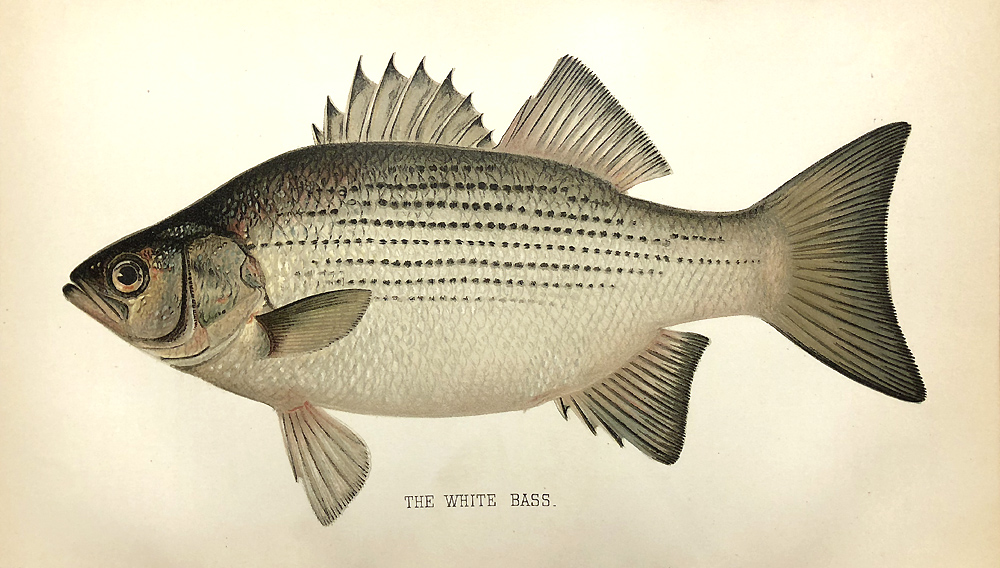We pack properly to protect your item!
The white bass or sand bass (Morone chrysops) is a freshwater fish of the temperate bass family Moronidae. It is the state fish of Oklahoma. White Bass are unrelated to the black basses, which are members of the sunfish family. White bass are found in brown lakes and some large rivers throughout the United States. The species is somewhat similar in appearance to the white perch, though larger. Its back is dark, with white sides and belly, and with narrow darkish stripes running lengthwise on the sides. The average fish ranges from 10 to 16 inches in length, and usually weighs from 1 to 4 pounds, though larger ones are sometimes taken. The world record is 6 lb (2.7 kg). 13 ounces and was taken in Virginia. Conventional panfish tackle or fly fishing tackle is used in angling the white bass. The fish tend to move in schools and prefer to swim in clear water. A closely related fish, though much less common, is the Yellow bass which is found predominantly in the Mississippi River. Some anglers enjoy eating fresh white bass, others avoid it, as it can tend on occasion to have oily flesh. White bass are carnivores. They eat insect larvae, crustaceans, and other fish. They are visual feeders. When not frightened, they will bite readily at live bait such as worms and minnows. Most fish are between one and three pounds, but some weigh as much as six pounds. White bass are native to the rivers that flow to the Mississippi. They have been widely introduced into rivers that flow in to the Atlantic Ocean, such as the Catawba and Yadkin rivers. White bass often travel in schools, chasing baitfish in the open waters of lakes and large rivers. As a result, they are rarely associated with cover. They also inhabit ponds, reservoirs, streams and rivers with deep pools. White bass have a strong homing tendency. They are known to find their home spawning ground even if it's moved to a different part of the same lake. They like to spawn in moving water in a tributary stream, but they will spawn in windswept lake shores. They spawn during daylight. Females release 242,000 to 933,000 eggs which stick to the surface of objects. The parents move to deeper water and do not care for the young fish. The young fish live in shallow water for a while until they move to deeper water. They can also spawn with yellow bass to create the yellow bass hybrid. White bass are active feeders during the spawn. Sherman Foote Denton (1856-1937) was born in Wellesley, Massachusetts , S.F. Denton was a multi-talented artist, scientist and skilled entrepreneur in business. His interest in natural history encompassed not only fish, but butterflies and moths, insects, birds, fossils, freshwater pearls and gems. During the 1880s, he and his brothers went on trips to the Western U.S. and accompanied their father, a geologist, on an expedition to Australia, New Zealand and New Guinea, where collected natural history specimens. Returning to the U.S., Denton worked as an artist for the United States Fish Commission at the Smithsonian Institute between 1896 and 1890, where he illustrated their reports with chromolithograph prints and also developed and patented a method for mounting fish without losing the natural colors. He became the leading maker of fish models for collectors and museums such as the Smithsonian, the Field Museum in Chicago and the Agassiz Museum at Harvard. He also invented a method for mounting butterflies, and amassed the most important collection of freshwater pearls in the U.S. Sherman, along with his brothers William, Winsford and Shelley (a noted naturalist in his time) became famous at the 1900 Paris Exposition for their award-winning moth and butterfly collections. Sherman Denton was also renowned among the leading naturalists of his day for developing and patenting methods to preserve fish, butterflies and moths in a much more life-like state.
| |
